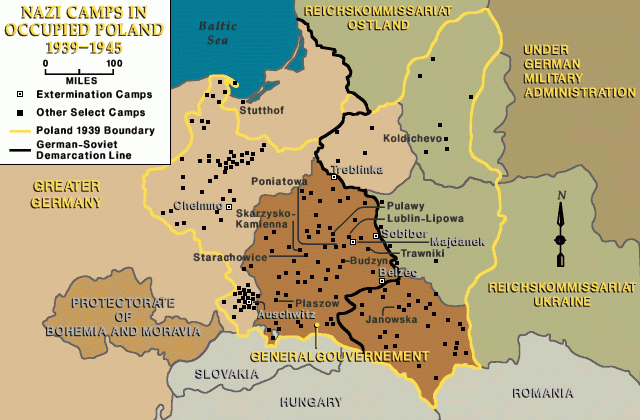| |||||||
| Search Forums |
| Advanced Search |
| Go to Page... |
 |
| Search this Thread |  23,137 views |
| | #1 |
| Senior - BHPian Join Date: Jan 2013 Location: Pune
Posts: 1,248
Thanked: 6,072 Times
| Germany: Visit to the Dachau Concentration Camp Memorial There are some places that instill a sense of instant and absolute happiness when you visit them. There are some that bring about that nostalgic, deja vu feeling. But then there are some that haunt you, long after you have visited them. This travelogue belongs to the third category. However, calling it a travelogue is actually not the right way to define it. In fact, as I start writing this thread, I have not been able to think of a respectable alternative. Hopefully, as I pen down my experiences in this thread, something proper will pop up in my mind. So, recently, I was in Munich for a short business trip. Had some time off over a weekend and like any other car aficionado worth his/her salt, I straightaway went to the BMW Welt. But, as you might have guessed from the subject line, this thread is not about cars. This is about my visit to the town of Dachau, located about 10 miles away from Munich. Precisely speaking, this is about my visit to the Dachau Concentration Camp Memorial site, home to one of the world's most terrible tragedies in this generation, and possibly from the previous ones as well. As I stepped off the Dachau station, there were boards everywhere with a greeting sign (if you can call it that) to direct towards the memorial site:- 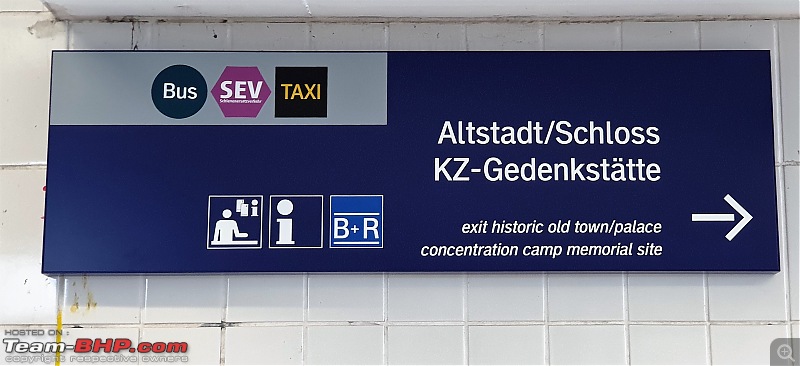 A bus ride took me through the sleepy town of Dachau towards the memorial site, a couple of videos depicting the sheer normalcy of this town:- For a town with a population of about 45,000 and with a heritage going back to the 9th century, not many tourists know about the historical significance of the town, including the Dachau Palace and Garden. The tourist attraction, which gets talked about the most when visiting this section of Bavaria, is the Concentration Camp Memorial Site.  In hindsight, now when I reminisce about what I had witnessed in the camp as a tourist/passer-by, all the sights make the hairs stand up on the back of my neck. There are many ways to describe or write about the Dachau memorial site, so I chose to keep things simple in terms of articulation and yet, have attempted to bring together the historical events leading to the formation of the camp, overview of the camp administration in general and life at the camp, among other things. Index of contents:- History and Prelude Categories of camps Classification system for prisoners Timelines List of major camps The Dachau camp - Part 1 The Dachau camp - Part 2 The Dachau camp - Part 3 Liberation and Trials Epilogue References Last edited by CrAzY dRiVeR : 26th March 2019 at 22:27. Reason: Thanks for sharing. Minor typos corrected. |
| |  (17)
Thanks (17)
Thanks
 |
| The following 17 BHPians Thank JoshMachine for this useful post: | akshay81, Avikbrio, CrAzY dRiVeR, Dhruv29, FORTified, Foxbat, GTO, GutsyGibbon, libranof1987, Lij, motorsan, naveenroy, PGA, sandeepmohan, Tejas@perioimpl, Turbanator, V.Narayan |
| |
| | #2 |
| Senior - BHPian Join Date: Jan 2013 Location: Pune
Posts: 1,248
Thanked: 6,072 Times
| re: Germany: Visit to the Dachau Concentration Camp Memorial HISTORY AND PRELUDE The patriotic enthusiasm that accompanied the outbreak of World War I in 1914 rapidly faded in light of the high number of deaths on the front and the difficulties at home in Germany. A sailors’ revolt in November 1918 escalated into a largely bloodless revolution that brought Imperial Germany to an end. Workers’ and soldiers’ councils took over the responsibility of governing. Different interpretations of the war, defeat, and revolution intensified the opposing views within German society. During the course of the war, the military leadership gained power and influence over the Kaiser and government. When the senior command recognized that the war was lost, it pressed for a transition to a parliamentary government at the end of September 1918. Under the pressure of the defeat of war and the first revolutionary uprisings in the Reich, the Kaiser abdicated on November 9, 1918. The period from the November Revolution in 1918 until May 1919 was dominated by debates about a new state and economic order. The German Social Democratic Party (SPD), the Catholic Center Party (Zentrum), and the Liberal German Democratic Party (DDP) spoke up for a parliamentary democracy and became the bearers of the new Republic. The peace treaty of Versailles, which was signed on June 28, 1919, declared the German Reich alone responsible for World War I. The peace treaty imposed heavy burdens on Germany. The Reich was required to cede territory, pay high reparations (war damages), drastically reduce its military forces, and allow the victorious powers occupation and control rights. All political forces rejected this “peace dictate” and demanded a “revision” of the agreement. The difficulties that emerged after the war was over – the adjustment from wartime production to peace-time production, the re-integration of soldiers returning home from war, money devaluation, and the reparations payments – reached a climax in 1923 when the mark rapidly lost value. The inflation divided German society into a small class of winners and a majority of losers. Large portions of the population fell into poverty. The economic recovery in Germany that began in 1924 ended in 1929 when the world economic crisis set in. The German Reich was hit particularly hard. The number of unemployed rose rapidly. Millions of people were without work and received little financial support. Many starved. The economic catastrophe served the interests of the antidemocratic movement. Both the National Socialists as well as the Communists used the situation to present themselves as “rescuers in times of need” and hence increasingly caught the attention of the population. Development of world trade ebbed at its lowest:-  Ghosts of unemployment raised their heads:-  National Socialism consolidated and radicalized a number of different political positions that were widespread in German society, in particular, nationalism, imperialism, Social Darwinism and resentments towards liberalism, democracy and the socialist workers’ movement. The ideas of the Nazi movement strove towards a “racially pure national body”. All “elements” that “weakened” it or which did not “fit in” were to be removed. Such notions gave expression to a racism in which people were classified and treated as superior or inferior according to biological characteristics. The National Socialists propagated above all hostile antisemitic images. Hatred of Jews was also a centuries old tradition in Germany. Jews were first discriminated against for religious and socially motivated reasons. Since the 19th century, more and more “race-ideological arguments” were being put forward. The National Socialists combined both forms – anti-Judaism and anti-Semitism. Election posters decreeing the lone survivor, Hitler:- 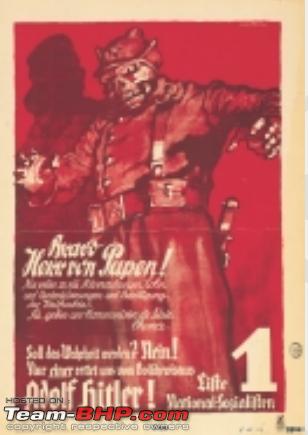 With a huge majority for Hitler's NSDAP:-  In both Reichstag elections of 1932, the NSDAP became the strongest party in parliament. A group of army generals, heavy industrialists, and big landowners pressured the Reich President, Paul von Hindenburg, to appoint Adolf Hitler Reich Chancellor. After Adolf Hitler became the head of government on January 30, 1933, the National Socialists established a dictatorship based on their ideas. Summarizing the road to dictatorship:- 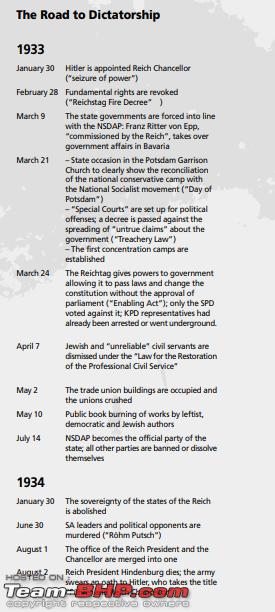 Immediately, the regime wasted no time and it resorted to acts like protective custody:- 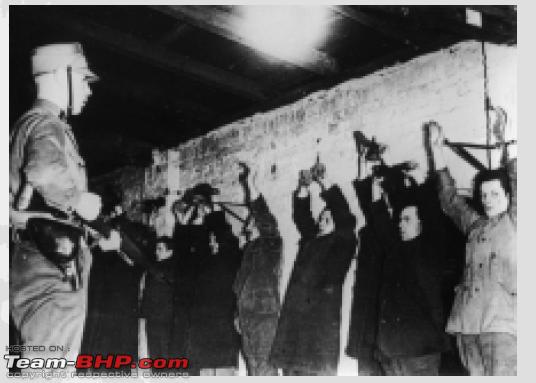 Under the Nazi regime, imposing unlimited “protective custody” was made possible by the “Reichstag Fire Decree”. It legitimized the arrest of National Socialist political opponents. Protective Custody orders were issued by the political police authority (Gestapo). There was no means of legal redress. Those who were taken into “protective custody”, without any legal rights or protections, were at the mercy of the Nazi organs of persecution. And thus, a series of disguised barbaric acts was set in motion - which culminated in prisoners being sent to the infamous concentration camps under the regime's strict enforcement. Back to index Last edited by JoshMachine : 26th March 2019 at 16:31. Reason: format |
| |  (11)
Thanks (11)
Thanks
 |
| The following 11 BHPians Thank JoshMachine for this useful post: | Avikbrio, CrAzY dRiVeR, dailydriver, Dhruv29, GTO, libranof1987, Lij, Mahesh Prasad, tharian, Turbanator, V.Narayan |
| | #3 |
| Senior - BHPian Join Date: Jan 2013 Location: Pune
Posts: 1,248
Thanked: 6,072 Times
| re: Germany: Visit to the Dachau Concentration Camp Memorial CATEGORIES OF CAMPS Between 1933 and 1945, Nazis and their allies established more than 42,000 major and subsidiary camps across the European hinterland. The perpetrators used these sites for a variety of purposes - including forced labor, detention and mass termination. Most people refer to the incarceration sites as concentration camps. However, going by the actual purpose, here are the various categories:-
Back to index Last edited by JoshMachine : 21st March 2019 at 17:46. |
| |  (13)
Thanks (13)
Thanks
 |
| The following 13 BHPians Thank JoshMachine for this useful post: | Avikbrio, CrAzY dRiVeR, dailydriver, Dhruv29, GTO, Insearch, libranof1987, Lij, PapaKiloSierra9, RoadSurfer, tharian, Turbanator, V.Narayan |
| | #4 |
| Senior - BHPian Join Date: Jan 2013 Location: Pune
Posts: 1,248
Thanked: 6,072 Times
| re: Germany: Visit to the Dachau Concentration Camp Memorial CLASSIFICATION SYSTEM FOR PRISONERS From 1938, Jews in the camps were identified by a yellow star sewn onto their prison uniforms, a perversion of the Jewish Star of David symbol. After 1939 and with some variation from camp to camp, the categories of prisoners were identified by a marking system combining a colored inverted triangle with lettering. The badges sewn onto prisoner uniforms enabled SS guards to identify the alleged grounds for incarceration.  Criminals were marked with green inverted triangles, political prisoners with red, "asocials" (including Roma, nonconformists, vagrants, and other groups) with black or—in the case of Roma in some camps—brown triangles. Homosexuals were identified with pink triangles and Jehovah's Witnesses with purple ones. Non-German prisoners were identified by the first letter of the German name for their home country, which was sewn onto their badge. The two triangles forming the Jewish star badge would both be yellow unless the Jewish prisoner was included in one of the other prisoner categories. A Jewish political prisoner, for example, would be identified with a yellow triangle beneath a red triangle. The Nazis required Jews to wear the yellow Star of David not only in the camps but throughout most of occupied Europe. And here is a picture that shows the decoding key for camp index files:-  Note that there are 4 types - first for the people that authorized confinement/punishment, second for the type of prisoner, third for the type of departure and fourth for the camp location. The SS were brilliant when it came to administration and record keeping in general, but alas, this diligence was almost always put to inhuman causes. Back to index Last edited by JoshMachine : 22nd March 2019 at 10:30. |
| |  (12)
Thanks (12)
Thanks
 |
| The following 12 BHPians Thank JoshMachine for this useful post: | akshay81, CrAzY dRiVeR, dailydriver, Dhruv29, GTO, Insearch, libranof1987, Lij, PapaKiloSierra9, tharian, Turbanator, V.Narayan |
| | #5 |
| Senior - BHPian Join Date: Jan 2013 Location: Pune
Posts: 1,248
Thanked: 6,072 Times
| re: Germany: Visit to the Dachau Concentration Camp Memorial TIMELINES
Back to index Last edited by JoshMachine : 22nd March 2019 at 10:45. |
| |  (8)
Thanks (8)
Thanks
 |
| The following 8 BHPians Thank JoshMachine for this useful post: | CrAzY dRiVeR, Dhruv29, GTO, Insearch, libranof1987, Mahesh Prasad, tharian, V.Narayan |
| | #6 |
| Senior - BHPian Join Date: Jan 2013 Location: Pune
Posts: 1,248
Thanked: 6,072 Times
| re: Germany: Visit to the Dachau Concentration Camp Memorial LIST OF MAJOR NAZI CAMPS   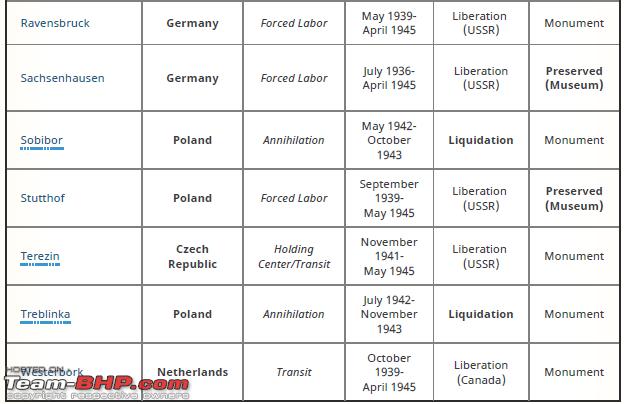 It is evident that none of the Germany-based camps had annihilation as the primary motto in the first place since the SS propaganda didn't allow it officially on German soil. That job was relegated to some of the Eastern camps, mainly those located in Poland. The concentration camp at Dachau was established north of Munich in March 1933 and remained in use until its liberation by American forces in April 1945. Originally intended as a camp for German political prisoners, by 1941 Dachau Concentration Camp accommodated an increasing influx of Jews, Gypsies, homosexuals, political prisoners, and some prisoners of war from Eastern Europe, the Balkans, France, and the Soviet Union. In addition to the main camp located southeast of the town of Dachau, the camp system grew to include a network of approximately 100 subcamps scattered throughout southern Germany and Austria. Most of these were “Arbeits Kommandos,” or work camps. The size of the camp population fluctuated continually throughout the war as large groups of prisoners were moved in and out to satisfy changing labor demands of the German war industry. In all, an estimated 206,006 prisoners from over 30 countries passed through Dachau and its outcamps from 1933 to 1945. The main camp was continually expanded to accommodate the ever-increasing number of inmates, which by August 1944 numbered approximately 22,000. By the spring of 1945, this figure rose to more than 60,000 with the arrival of prisoners from evacuated death camps in Poland. In April 1945, Allied authorities established the total camp population of Dachau and its subcamps at 65,613 prisoners, representing virtually every European nation, of whom the largest groups were Polish (14,053 prisoners) and Russian (12,363 prisoners). Political prisoners included religious leaders, members of political and intellectual elites, and military officers from Nazi-occupied Europe. Jews were largely confined to the 11 subcamps of the Landsberg-Kaufering area, which were considered the worst from the standpoint of overcrowding, malnutrition, disease, and brutality. Because records maintained at Dachau were incomplete or destroyed prior to the camp’s liberation, the exact number of deaths at the concentration camp is impossible to determine. Partial documentation cited 32,979 deaths between 1933 and 1945, but this figure omits thousands who died in the camp’s final months, as well as many others who died in transit to or from the camp. The largest number of deaths occurred in the last 6 months of the camp’s history, when extreme over-crowding from the arrival of prisoners from evacuated camps in Poland contributed to deaths from disease, malnutrition, and exposure. Prior to this period, inmate deaths resulted principally from overwork, illness, deliberate executions, suicides, and the effects of beatings and torture. Several thousand Soviet prisoners of war in 1941–42 were shot on arrival. Other inmates died as a result of medical experiments conducted at the camp. The next post onwards will carry specifics of the Dachau camp. Back to index Last edited by CrAzY dRiVeR : 26th March 2019 at 22:35. Reason: Thanks for sharing. Minor typos corrected. |
| |  (9)
Thanks (9)
Thanks
 |
| The following 9 BHPians Thank JoshMachine for this useful post: | CrAzY dRiVeR, Dhruv29, GTO, Insearch, libranof1987, PGA, tharian, V.Narayan, Vikram Arya |
| | #7 |
| Senior - BHPian Join Date: Jan 2013 Location: Pune
Posts: 1,248
Thanked: 6,072 Times
| re: Germany: Visit to the Dachau Concentration Camp Memorial THE DACHAU CAMP - Part 1 Dachau (1933-45), will stand for all time as one of history's most gruesome symbols of inhumanity. There our troops found sights, sounds and stenches horrible beyond belief, cruelties so enormous as to be incomprehensible to the normal mind. No words or pictures can carry the full impact of these unbelievable scenes but this report presents some of the outstanding facts in order to emphasize the type of crime which, elements of the SS committed thousands of times a day, to remind us of the ghastly capabilities of certain classes of men, to strengthen our determination that they and their works shall vanish from the earth. - Signed: William Quinn, Colonel, 7th US Army. The above is a foreword from the report prepared by the Office of Strategic Services section of the 7th Army, which was primarily responsible for the liberation of the Dachau camp. Some very disturbing thoughts penned in the above paragraph! ------------------------------------------------------------------------------ To start off this post, showing the aerial view of the facility captured during the liberation:- (For reference, this is diagram #1)  With the original picture back in 1945:-  The Dachau camp site in 1930s was originally a discarded ammunition factory from the World War I days.  The same view captured in 2006:-  A synopsis of the proceedings at the camp right from 1933 to 1945:-   Important subsidiary camps:- 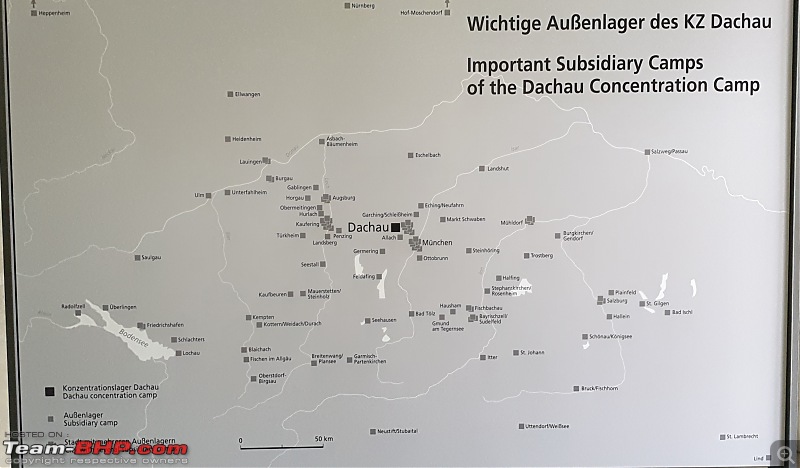 At the entrance of the memorial, a plaque reminds you of few important rules of conduct:-  followed by the memorial layout:- 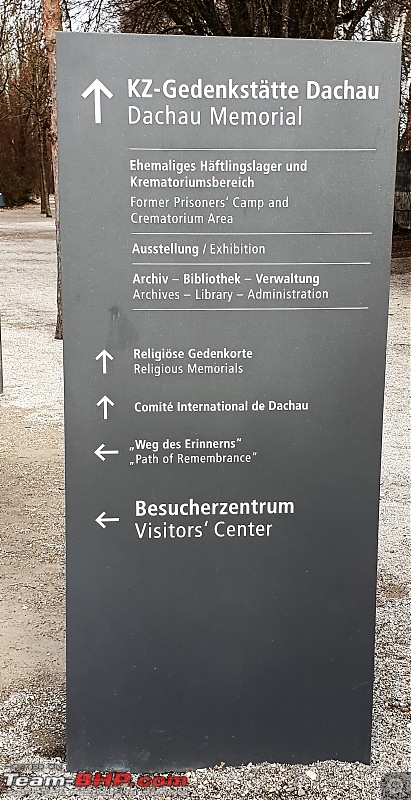 Going back to the reference of diagram #1 shown above, the SS main guardhouse (now demolished) stood at the entrance of the concentration camp back in those days:- 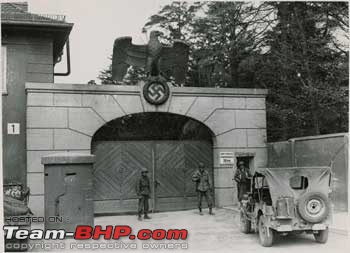 and the path leading to the main prisoner camp:- 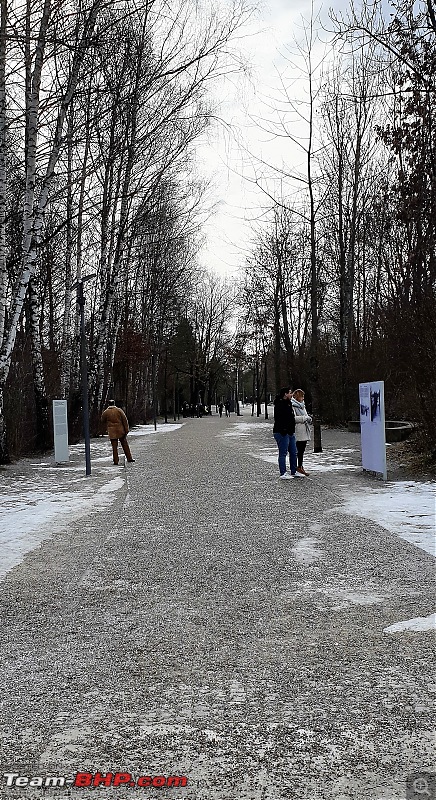 which, in those days was something like this:-  Next up is the Jourhaus, which is the entrance to the main prisoner camp. Back in 1945, it used to look like this:-  The railroad tracks can be seen towards the right of the above image, which were primarily used for transportation of goods into the prisoner camp. When I clicked this picture a month ago, the slightly reconstructed structure looked like this:  When you reach the actual Jourhaus gate, you come across another iconic structure:-  It reads "Arbeit macht frei", which means "Work sets you free" or "Work brings freedom". The slogan was allegedly coined by Hitler's main propaganda minister Josef Goebbels in an effort to convince the public that the Nazi concentration camps like Dachau were merely work camps designed to politically rehabilitate Communists, Social Democrats and anarchists. The saying played down the role of Dachau, portraying it as a "labour and re-education camp". At the same time, this usage of the saying manifested the cynical inhuman attitude towards the prisoners, for forced labor was a key instrument of Nazi terror. However as history would have it, the gate was stolen in 2014 by unknown persons. In early December 2016, an anonymous tip-off to the Norwegian police in the town of Bergen led to the recovery of the stolen gate. It is now shifted inside the exhibition, the original gate shown below:-  On both sides of the entrance gate, are 2 plaques in honor of the US Army divisions, who liberated the Dachau inmates:-   A short video depicting the gloom immediately upon entering the prisoner camp area through the gate:- And a few pictures for added effect:-  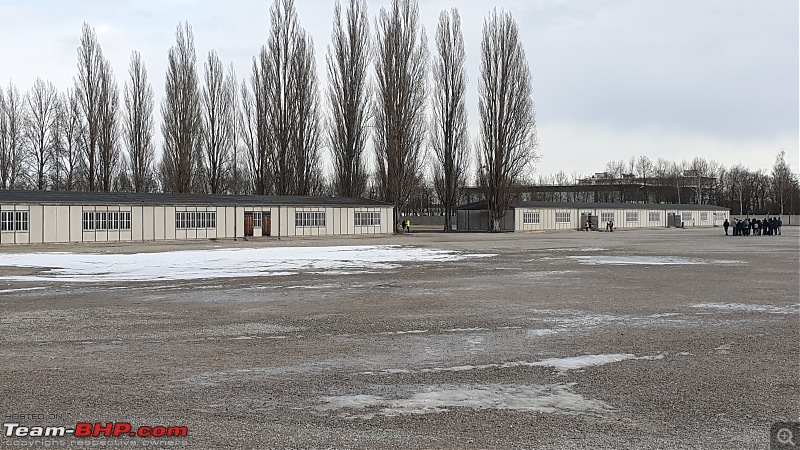 The layout of the prisoner camp area:- (for reference, this is diagram #2)  The maintenance building of the yesteryears:-  On the top of the building was written: "There is one road to freedom. Its milestones are: Obedience, Diligence, Honesty, Orderliness, Cleanliness, Sobriety, Truthfulness, Self-Sacrifice, and Love of the Fatherland." And the reconstructed structure as of today:-  Entrance to the museum/exhibition, which reiterates that the entry is not advisable for children below the age of 12:-  Upon entering the exhibition, this board sets the context of the reconstruction:-  Next up is information related to the camp viz, setting up, prisoners and the beginning of the SS rule. On March 20, 1933, Heinrich Himmler, Reichsführer SS and temporary chief of police in Munich, publicly announced that “in the interests of state security” a concentration camp had been established for the many political opponents who had been arrested. The camp, which had been set up in the buildings of an empty gunpowder and munitions factory near Dachau, was initially placed under the command of the regional police. The first prisoner transport arrived on March 22, 1933.  On April 11, 1933, the SS took over the command of the Dachau concentration camp from the regional police. Hilmar Wäckerle became the new camp commander and with him began the reign of terror in Dachau. SS men regularly humiliated and mistreated prisoners. By the end of May 1933, they had murdered twelve prisoners, mostly well-known Nazi opponents and Jews. After the judiciary began an investigation into these murders, Himmler had Wäckerle replaced by Theodor Eicke in June 1933. Eicke and Himmler hindered the investigation by the prosecuting attorney’s office and the case was eventually dropped.  Himmler:-  And Theodor Eicke, the (in)famous Dachau Commandant and Inspector of the Concentration Camp system:-  After he was appointed commandant on June 26, 1933, Eicke imposed camp rules and regulations regarding the treatment of prisoners on October 1st, 1933. His aim was to intimidate, humiliate and terrorize the prisoners. He also introduced a new administrative structure. Eicke had a decisive influence on the racist and inhuman content in the training of concentration camp guard units and SS leaders. Between 1934 and 1939 he was head of the Inspectorate for the Concentration Camps, the direction and control authority of the National Socialist camp system. In this capacity he applied the Dachau regulations to all the existing and newly founded camps. Theodor Eicke introduced a tightly structured administrative organization. That is how he achieved the prerequisites for the complete regimentation, repression and exploitation of the prisoners. The commandant staff was organized into five divisions: the commandant headquarters and attached offices of the adjutant, the political division, the prison camp direction, the administrative leadership and the medical division that was headed by the camp doctor. The commandant staff and, in particular, the SS block leadership, strongly influenced the tyranny in the camp. Certain prisoners, appointed by, checked by and dependant on the SS, took on special administrative and disciplinary responsibilities in the barracks and in the work details. During the reorganization of the existing camps and the establishment of new concentration camps, Theodor Eicke, as inspector of the concentration camps, deliberately appointed, as of 1934, SS leaders and guard troops who had received their training at Dachau. These SS leaders ensured that the “Dachau model” would be applied to the other camps. They occupied key positions, developed a close network and had an influence on personnel policy. They passed on to the younger SS men the “Dachau spirit“, which was characterized by hatred and contempt for the prisoners. Back to index Last edited by CrAzY dRiVeR : 26th March 2019 at 22:36. Reason: Thanks for sharing. Minor typos corrected. |
| |  (9)
Thanks (9)
Thanks
 |
| The following 9 BHPians Thank JoshMachine for this useful post: | comfortablynumb, CrAzY dRiVeR, Dhruv29, GTO, libranof1987, PapaKiloSierra9, tharian, V.Narayan, Vikram Arya |
| | #8 |
| Senior - BHPian Join Date: Jan 2013 Location: Pune
Posts: 1,248
Thanked: 6,072 Times
| re: Germany: Visit to the Dachau Concentration Camp Memorial THE DACHAU CAMP - Part 2 Theodor Eicke introduced a tightly structured administrative organization. That is how he achieved the prerequisites for the complete regimentation, repression and exploitation of the prisoners. The commandant staff was organized into five divisions: the commandant headquarters and attached offices of the adjutant, the political division, the prison camp direction, the administrative leadership and the medical division that was headed by the camp doctor. The commandant staff and, in particular, the SS block leadership, strongly influenced the tyranny in the camp. Certain prisoners, appointed by, checked by and dependant on the SS, took on special administrative and disciplinary responsibilities in the barracks and in the work details.  During the reorganization of the existing camps and the establishment of new concentration camps, Theodor Eicke, as inspector of the concentration camps, deliberately appointed, as of 1934, SS leaders and guard troops who had received their training at Dachau.  These SS leaders ensured that the “Dachau model” would be applied to the other camps. They occupied key positions, developed a close network and had an influence on personnel policy. They passed on to the younger SS men the “Dachau spirit“, which was characterized by hatred and contempt for the prisoners. In terms of the general administration at the camp, almost everything was formalized and documented. The prisoner daily routine:-  Prisoners' belongings during entry:-  And when the prisoner is deceased :-  Any family artefacts:-  And even the death register!!  Samples for some of the artefacts are on display at the exhibition:-  Upon entry, the prisoners' heads were shaved and disinfected, a sample shaving set used by one of the barbers:-  More than the hygiene, this was aimed at degradation of the physical being of the prisoners, immediately upon their entry into the camp. Followed by disinfection, all of such activities were overseen by foremen designated as "Capos":-  Twice a day, all inmates were required to present themselves for the roll-call on the open ground:-    And this was to be done under all weather conditions, cold/harsh winters or wet rains - resulting in lot of physical distress for the prisoners. Any resistance to work or even a hint of insubordination, led to drastic actions such as hanging by the pole:-   or a very horrific thrashing by the SS guards, leading to almost certain death:-  Sometimes prisoners tried to escape, and chose to get electrocuted on the fence to avoid the harsh punishments:- 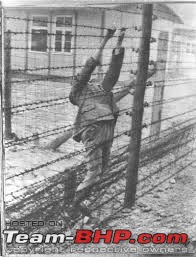  The fence as seen today:-  As a mark of respect, the International Monument erected on the grounds portrays this gruesome fact:- 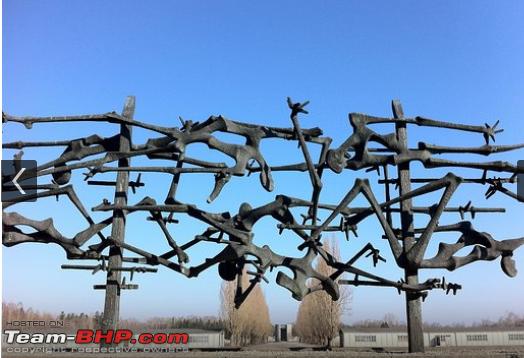 The Monument was formally dedicated in September 1968. The photo above shows the sculpture created by Nandor Glid.  The sculpture is made of dark bronze. It features short strands of barbed wire on which skeletons are hanging with their heads dangling sharply. On either side of the sculpture are concrete fence posts which closely resemble the ones actually used to support the barbed wire fence around the camp. Underneath the sculpture are the dates 1933 - 1945, the years that the camp was used as a concentration camp for anti-Nazis. In 1937–38 the inmates had to tear down the prisoner camp to build a visibly larger camp complex that was to accommodate 6,000 prisoners. The Jourhaus, where the SS camp command was housed, the maintenance building, detention block (Bunker) and 34 barracks were among the newly constructed buildings.   As of today, they have been razed and only the barrack numbers remain to stand testimony:-   Next to the prisoner camp was the SS area with extended barracks, workshops and provision, living and recreation facilities. These grounds were also extended. By the end of the war the Dachau concentration camp covered an area of over 1.5 square kilometers. Outside the barracks, towards the perimeter of the camp, were large guard towers, meant to supervise the proceedings and shoot down any escaping prisoner:- 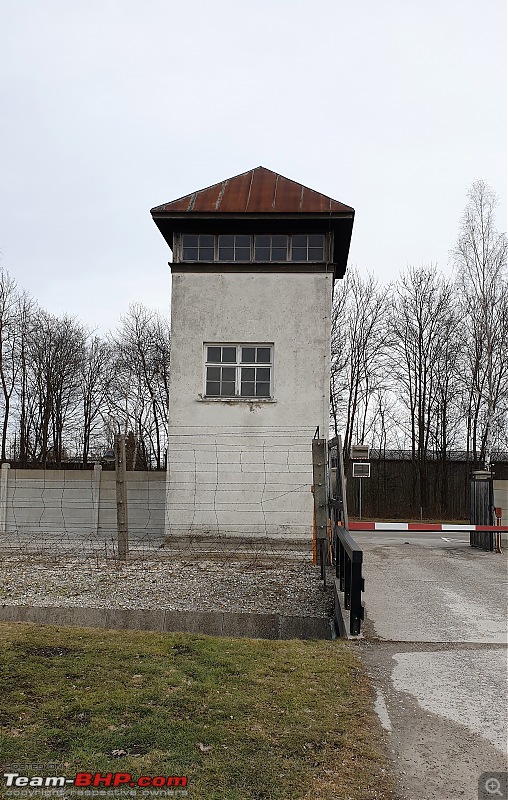 And between these towers, ran a series of a moats with electrified fences:-  Inside the barracks, the conditions inmates had to adjust in cramped beds:- 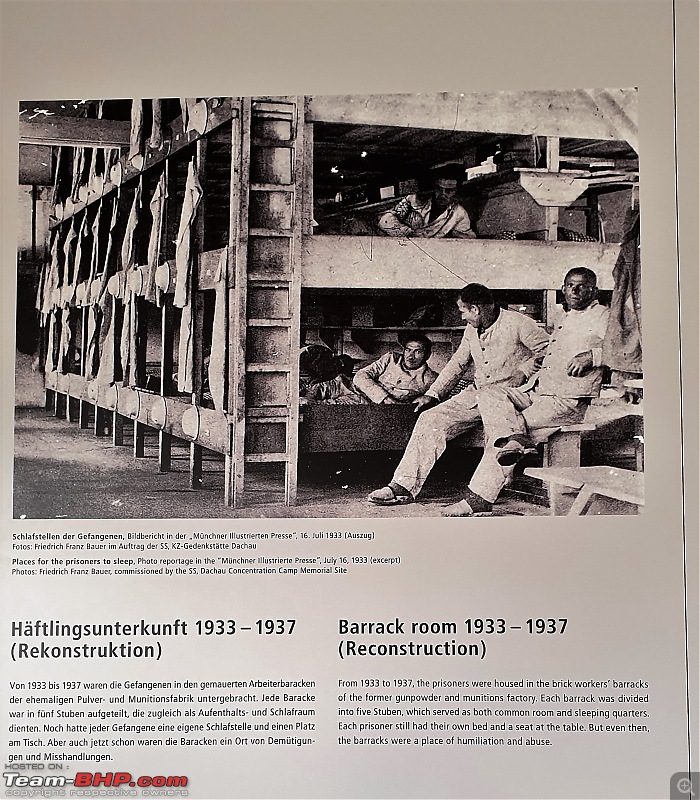 When viewed up & close as of today, the lack of decency in terms of basic living stands out very harshly:- 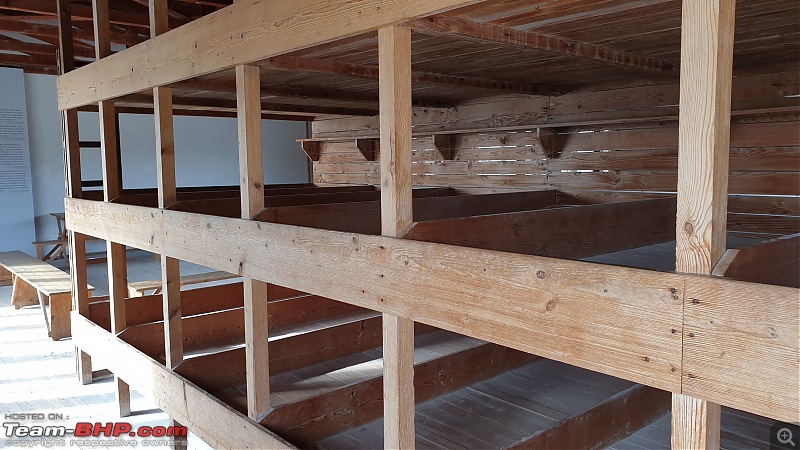  Back to index Last edited by JoshMachine : 26th March 2019 at 16:32. |
| |  (9)
Thanks (9)
Thanks
 |
| The following 9 BHPians Thank JoshMachine for this useful post: | akshay81, comfortablynumb, CrAzY dRiVeR, GTO, libranof1987, PapaKiloSierra9, tharian, V.Narayan, Vikram Arya |
| | #9 |
| Senior - BHPian Join Date: Jan 2013 Location: Pune
Posts: 1,248
Thanked: 6,072 Times
| re: Germany: Visit to the Dachau Concentration Camp Memorial THE DACHAU CAMP - Part 3 Some comments by inmates for the living conditions depict the grim reality:-  Views of drawers for inmates:- 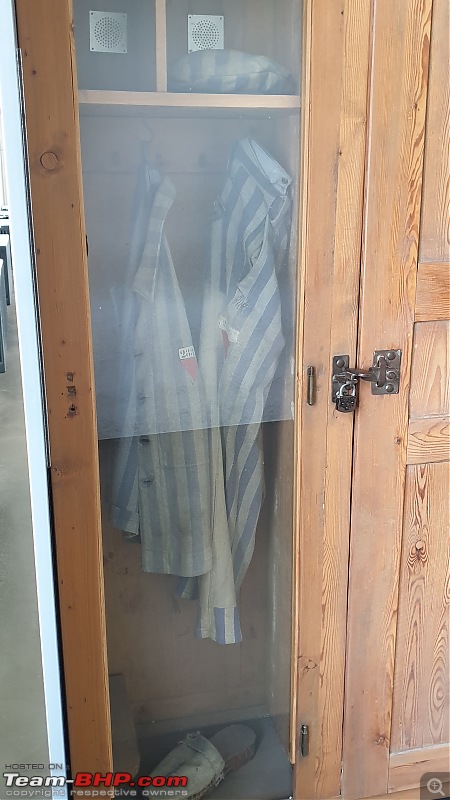  And the provided facilities were grossly inadequate to meet the needs of a huge volume of inmates, again pointing to the fact that this was all deliberately planned as part of the larger strategy to degenerate and degrade the sanctity of the populace:-   Over a period of time, conditions began to deteriorate so rapidly due to overcrowding that it showed in the prisoners' health. They started dying.   Many prisoners suffered as a result of malnutrition from diseases such as tuberculosis, dysentery and the dangerous phlegmon, an infection of the cell tissue. Between 1940 and 1942 the medical care of the ill prisoners lay almost exclusively in the hands of male nurses who had no training at all. The responsible SS doctors did hardly anything to look after the ill. Doctors in the ranks of the prisoners were prohibited from offering any assistance in treating the ill. Amongst the male nurses were henchmen of the SS, but even those willing to help also had their hands bound by the extremely difficult conditions. There were hardly any medicines available. The sick-bay thus became a place of death.  After the start of the war punishment was inflicted in an even crueler manner. For instance, the torture of “pole hanging” was made more horrific by hanging the prisoners from a beam in the baths so that they now hung suspended and no longer against a pole. Draconian penalties were imposed for the slightest reason, for instance for insufficient work performance, for an imperfectly made bed, for whenever a finger print could be seen on the surface of a locker or the trace of a dried water drop in the eating bowl, whenever a cigarette butt or tobacco crumble was to be found in pockets, whenever a button was missing or not done up, whenever a prisoner had his hands in his pockets, or was caught doing other similar “punishable acts”.  In the interim, the “Final Solution of the Jewish Question” was carried out everywhere. Following the invasion of the Soviet Union in June 1941, the “Einsatzgruppen of the Security Police and SD“, along with other SS and police units, had by 1942 murdered well over 500,000 people in the conquered territories. “Operation Reinhardt” – the systematic extermination of Polish Jews in the specially prepared extermination camps Belzec, Chelmno, Sobibór, Majdanek, Treblinka and Auschwitz – began in the spring of 1942. The third stage, at the end of 1942, has come to be symbolized by the name AuschwitzBirkenau, where Jews from the Reich and occupied Europe were deported to. Everyone who was unable to work – children, women, elderly and sick – were terminated directly in gas chambers; the rest were forced to endure the process of “extermination through work“. After Hungary was occupied in March 1944, the last large Jewish community in Europe was deported to the extermination camp of Auschwitz. A small number was sent to concentration camps in the territory of the Reich to do forced labor. At least six million people fell victim to the genocide of European Jews, as per varied reports. 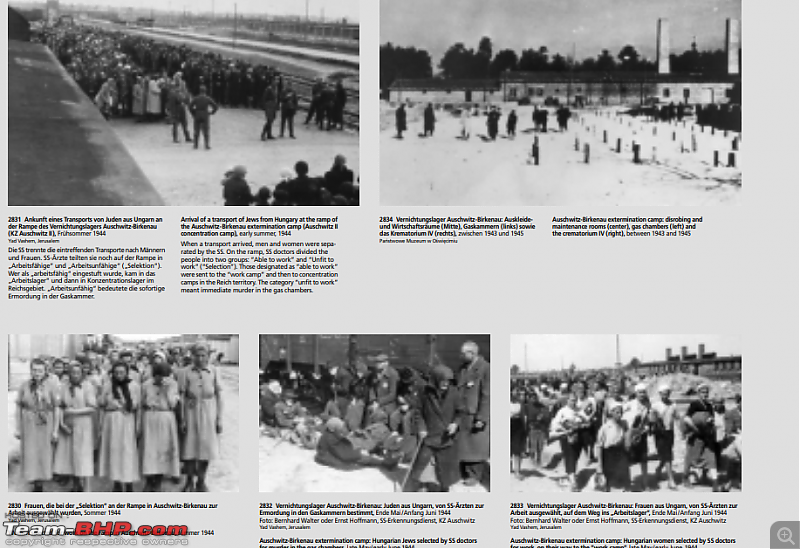 During the war concentration camp prisoners were also abused in murderous experiments for military medicine. In the course of the war these experiments were organized and registered as a component in the Reich Research Program. The most important experiments of those conducted in the Dachau concentration camp included: – the malaria experiments which stood in connection with the planned settlement of the southern regions of the Soviet Union  – the so-called bio-chemical and sulfonamide experiments for the treatment of infected wounds – the aeronautic medical experiments for research into the possibility of survival at great altitudes or in marine distress. 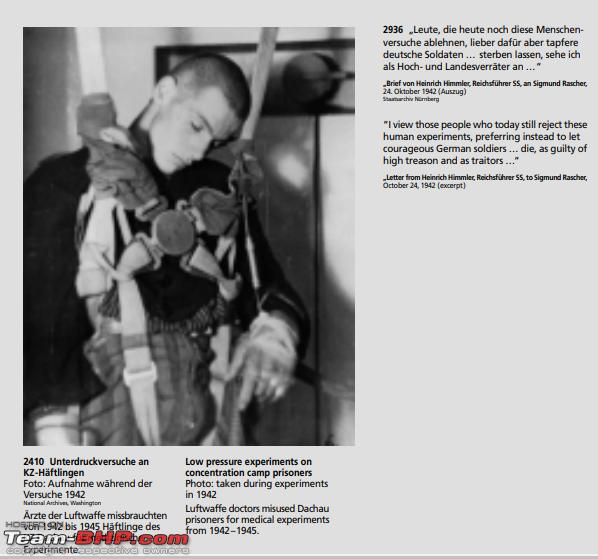   An ever increasingly complex system of prisoner transports developed in the course of the war. In order to satisfy the constantly rising labor demand of the German armaments industry, the regime had hundreds of thousands of persons from the Reich and, above all, from the occupied territories deported to the concentration camps as forced laborers. At the “slave market” in the main concentration camps, the SS and often industry representatives decided upon their distribution and assignment. The prisoners were transported back and forth between the individual camps according to prevailing needs. The inhuman conditions under which all these transports were run cost the lives of numerous prisoners. During a transport from the French camp Compiègne for example nearly 1,000 fatalities were counted. A major part of these prisoner transports also served to take away the uncounted “invalids” unfit for work to the extermination and death camps. The prisoner transports resulted in another grave problem - that of the typhus epidemic and subsequent more deaths.  With defeat looming it became increasingly important to the SS to remove evidence of the crimes committed in the concentration camps. At the Dachau concentration camp they began with the destruction of incriminating evidence in April 1945. In addition, plans for murdering the prisoners were worked out under the code names “Wolke A I” [“Cloud A I”] and “Wolkenbrand” [“Cloud fire”], which were never carried out. The first measures for evacuating the camp began in mid-April. The prisoners were to be evacuated in the direction of the Tyrol. On April 26, over 10,000 prisoners were forced to leave the Dachau concentration camp on foot, in trains, or in trucks. The largest group of some 7,000 prisoners was driven southward on a march lasting several days. More than 1,000 prisoners did not survive the “death march”. Overall, the evacuation transports cost many thousands of prisoners their lives. In the early days of the Dachau concentration camp, there were few deaths compared to the travesty which took place after January 1945 when thousands of survivors from the eastern death camps were brought to the over-crowded camps in Germany, including Dachau. Almost half of the deaths in the Dachau camp occurred in the final five months of the war, as the typhus epidemic raging in the eastern camps spread to the German camps, carried by the new arrivals. In the first years of the camp, before World War II started on Sept. 1, 1939, only a small crematorium with one oven was needed. In all of the concentration camps, the corpses of those who died in the camps were burned on the orders of Heinrich Himmler in an effort to prevent the spread of disease and the contamination of the ground water. But even this did not stop the devastating typhus epidemic which accounted for the deaths of untold thousands of prisoners in the Nazi camps.  The area where the crematoria are located was off limits to the prisoners and hidden from them by a row of poplar trees on the west side of the prison compound. However, the crematoria area was close enough to the prison barracks that the inmates could smell the burning flesh when bodies were cremated. Pictures of the old crematorium:-   In order to cater to the terrifyingly increasing death rate, a new crematorium was built, ominously called Barracke X. 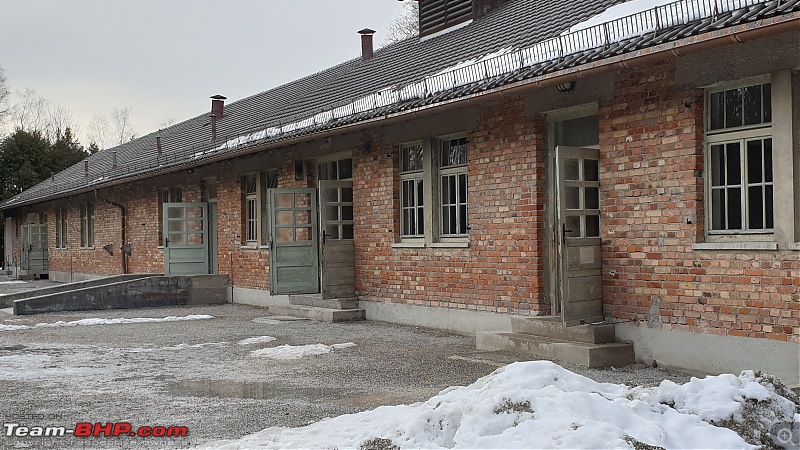  As seen above, the layout of this new crematorium had everything accounted for - rather chillingly - the disinfecting chambers, waiting room, disrobing room, the gas chamber, the death chamber, the incinerator room and the living quarters of the SS.  Most hangings were carried out here. The victims were hanged directly in front of the burning ovens.  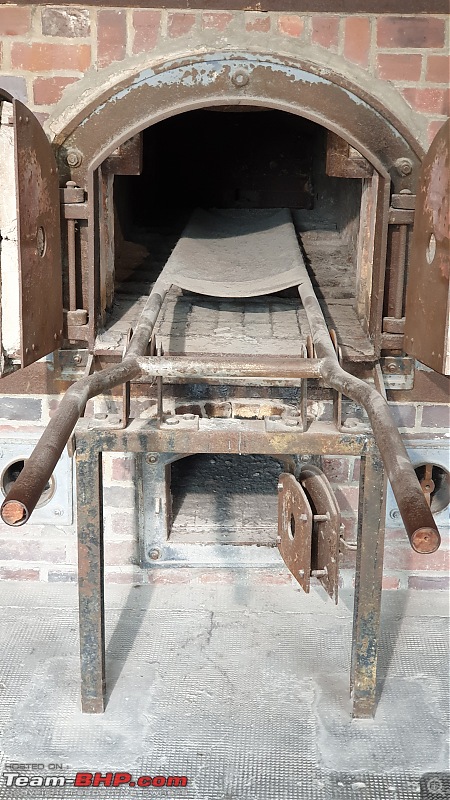 The disinfection chambers, used for de-lousing the infected clothes of the inmates:-  The waiting room/ disrobing room where the inmates were told to be ready for the "showers":-  The purported gas chamber shown below. The room was disguised to be having "showers" to mislead the victims and prevent them from refusing to enter the room. Some reports claim that upto 150 people could be suffocated to death through the poison gas. However, going with the theory of no extermination camps allowed on German soil, and also with contradictory evidences of historians on the usage of these chambers, plus the fact that the memorial administration also had put up signs near the crematorium - there is no clear or conclusive evidence that the Dachau gas chamber was actually used for mass gassing of prisoners.  The death chamber, where the dead were to be brought before they were cremated, notice the square-shaped drains located in the room - used for draining off any fluids from the bodies:- 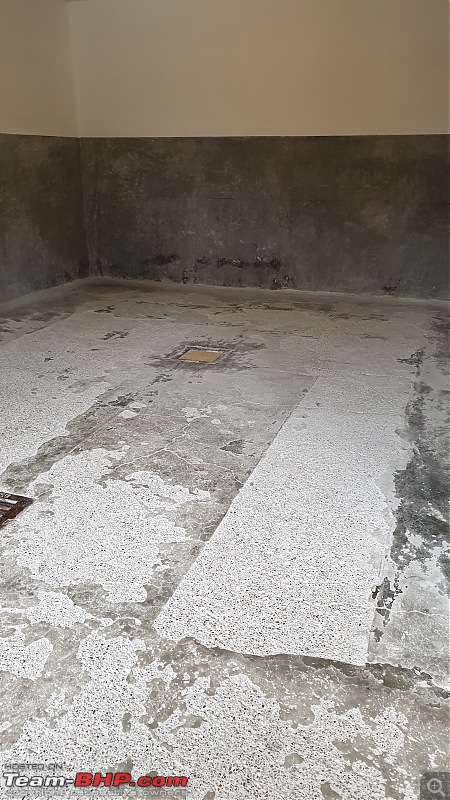 And the fatal Prussic acid/Zyklon B poison:-  A pile of victims outside the crematorium:- 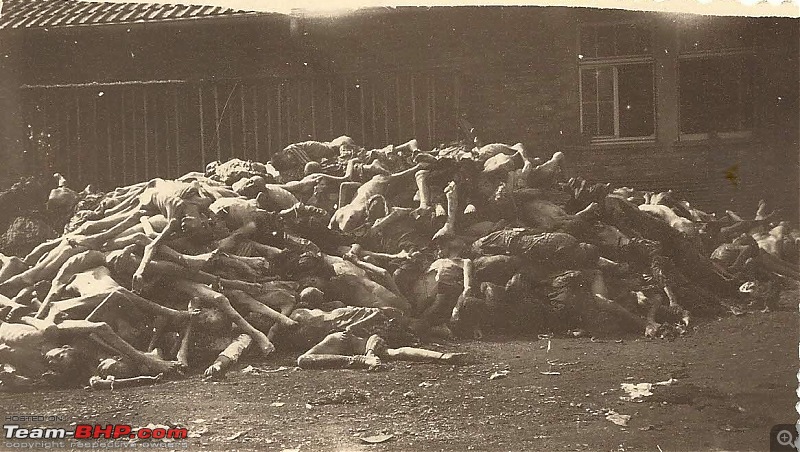 Another heart-wrenching picture, wedding bands of the victims:-  Back to index Last edited by JoshMachine : 26th March 2019 at 16:32. |
| |  (10)
Thanks (10)
Thanks
 |
| The following 10 BHPians Thank JoshMachine for this useful post: | akshay81, comfortablynumb, CrAzY dRiVeR, Dani7766, Foxbat, GTO, Insearch, PapaKiloSierra9, tharian, Vikram Arya |
| | #10 |
| Senior - BHPian Join Date: Jan 2013 Location: Pune
Posts: 1,248
Thanked: 6,072 Times
| re: Germany: Visit to the Dachau Concentration Camp Memorial Liberation and Trials 29th April, 1945. It was a Sunday, just after the noon meal, and the air was unusually still. The big field outside the compound was deserted. Suddenly someone began running toward the gate at the other side of the field. Others followed. The word was shouted through the mass of gray, tired prisoners. "Americans"! That word repeated, yelled over the shoulders in throaty Polish, in Italian, in Russian, and Dutch and in the familiar ring of French. The first internee was shot down as he rushed toward the gate by the guard. Yet they kept running and shouting through eager lips and unbelieving eyes. Americans! Dachau Liberated.   To the American veterans of World War II, the liberation of the Communist and Jewish prisoners at Dachau has become symbolic of what they were fighting against. As General Eisenhower said, the American soldier might not have known what he was fighting for, but at least, after seeing the concentration camps, he knew what he was fighting against. "We ride in a Jeep with a guard out ahead of the boys and we were several hundred yards ahead as we approached the Camp. The first thing we came to was a railroad track leading out of the Camp with a lot of open box cars on it. As we crossed the track and looked back into the cars the most horrible sight I have ever seen (up to that time) met my eyes. The cars were loaded with dead bodies. Most of them were naked and all of them skin and bones. Honest their legs and arms were only a couple of inches around and they had no buttocks at all. Many of the bodies had bullet holes in the back of their heads. It made us sick at our stomach and so mad we could do nothing but clinch our fists. I couldn't even talk. We then moved on towards the Camp and my Jeep was still several hundred yards ahead. As we approached the main gate a German officer and a civilian wearing an International Red Cross band and carrying a white flag came out. We immediately filed out and I was just hoping he would make a funny move so I could hit the trigger of my tommy gun. He didn't however, and when he arrived abreast of us he asked for an American officer. I informed him he a was talking to one and he said he wished to surrender the camp to me". - by 1st Lt. William Cowling, who was with Brig. Gen. Linden, 42nd Division.  The photograph above shows 2nd Lt. Heinrich Wicker standing in front of the gatehouse into the Dachau camp after the camp was liberated. Brig. Gen. Henning Linden is standing on the bridge over the Würm river as he directs American soldiers who are trying to get the prisoners back inside the camp. There are many stories about the SS guards at Dachau being beaten to death by the prisoners after the liberation or shot with guns provided by the American liberators, and many accounts of the guards being summarily executed by the liberators after the surrender. Several American soldiers who arrived after the liberation reported seeing the mutilated bodies of German soldiers lying in the camp and near the "death train" outside the camp. No one knows if 2nd Lt. Wicker was among those who were brutally murdered that day. Since the day of the surrender, he has been missing, and is presumed dead.   The 45th Thunderbird Division, had come upon an abandoned train of railroad cars just before they entered the SS training camp through the railroad gate on the west side of the Dachau SS complex. They were sickened by the sight of a long line of railroad cars filled with the dead bodies of emaciated prisoners, some dressed in rags but others naked. And then some near the crematorium also:- 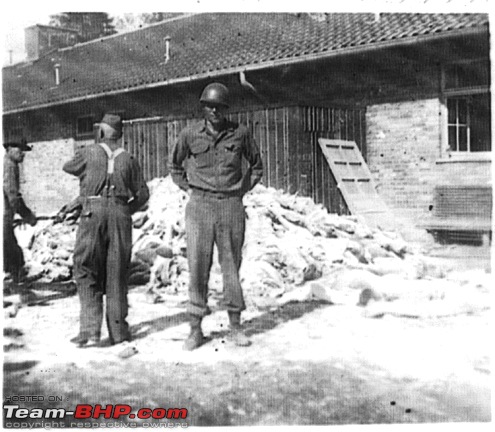 A proper burial was arranged.  Chronology of the final days leading to the liberation:- 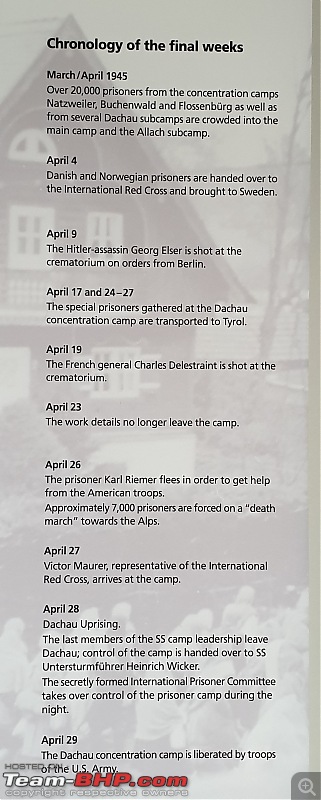 The Dachau trials were held for all war criminals caught in the United States zones in occupied Germany and Austria, as well as for those individuals accused of committing war crimes against American citizens and its military personnel. The trials, which were held within the walls of the former Dachau concentration camp, were conducted entirely by American military personnel whose legal authority had been conferred by the Judge Advocate General's Department within the U.S. Third Army. Between November 1945 and December 31, 1947, there were 489 cases brought before the American Military Tribunal at Dachau. There was a total of 1,672 persons who were tried; 1,416 of them were convicted and then sent to War Criminals Prison #1 at Landsberg am Lech for execution or incarceration. There were 297 death sentences, and 279 sentences to life in prison. Between 1946 and 1951 there were 284 death sentences carried out at Landsberg, which included the death sentences at the Nuremberg International Military Tribunal. The 1,672 accused war criminals who faced the American Military Tribunal at Dachau had been selected from a group of 3,887 people who were initially accused. The last of those who were not put on trial were finally released from their imprisonment in War Crimes Enclosure No. 1 at Dachau in August 1948. By 1958, the last of the German war criminals, convicted at Dachau, had been released from the War Criminals Prison #1 in Landsberg. A snapshot of the key war criminals:-  It was not until 1948 that the newly-created United Nations announced a law against genocide. With no existing laws in place, the Allies had to create new international laws in order to convict and punish the guilty. A new concept of collective guilt was formulated in order to see that justice was done. The basis for the Nuremberg IMT, as well as for the American Military Tribunal at Dachau, was that the German war criminals had participated in a "common design" to commit war crimes. The prosecution had only to prove that the accused had participated in a common plan by virtue of his position on the staff of a concentration camp, whether or not he had personally committed any atrocities. The accused in the "Dachau trials" were not charged with committing any specific crime, but rather with aiding and abetting the commission of crimes in the concentration camp system which was designated by the Allies to be a criminal enterprise. Back to index Last edited by JoshMachine : 26th March 2019 at 16:33. |
| |  (12)
Thanks (12)
Thanks
 |
| The following 12 BHPians Thank JoshMachine for this useful post: | akshay81, comfortablynumb, CrAzY dRiVeR, GTO, Insearch, libranof1987, naveenroy, nishsingh, PapaKiloSierra9, tharian, VaibhaoT, Vikram Arya |
| | #11 |
| Senior - BHPian Join Date: Jan 2013 Location: Pune
Posts: 1,248
Thanked: 6,072 Times
| re: Germany: Visit to the Dachau Concentration Camp Memorial Epilogue Frankly speaking, I hadn't planned to include this epilogue in the original scheme of things. But then, I thought it wouldn't be right to just end it abruptly without paying a homage. When I was in Munich, I would have spent about 3 hours or so at the Dachau Camp Memorial Site. But these few hours have triggered a plethora of many emotions and feelings that have moved me, and am sure, will continue to do so in the time to come. Through this experience-sharing write-up (somehow, am not comfortable to label it as a travelogue), I have attempted to capture and present some of the myriad feelings that I have experienced during my visit. The intention is to bring it out all in the open so that everyone is aware of the atrocities that happened back there in that camp, and the insurmountable, incurable trauma that everyone underwent. And the intention is to preserve the legacy of the monument so that all future generations never forget, and they learn from the history of what had happened at Dachau. As I walked around the camp site, I could notice memorials/chapels of different religions built all around the camp, most probably because the detainees were from so many countries and of different religious faiths. To quote German Chancellor Angela Merkel: “Maintaining this memory and monument pays tribute to the victims and serves to shape our lives of today and tomorrow. This memory is inseparably linked to our resolute and constant opposition to any form of radicalism, anti-semitism and racism - and to the defence of human rights, peace, liberty and freedom of expression. Only by working together in Europe can we preserve and strengthen these principles, so very precious and yet so vulnerable, that constitute the foundations of life with dignity.” On a monument erected in the camp, are these words: May the example of those who were exterminated here between 1933-1945, because they resisted Nazism, help to unite the living for the defence of peace and freedom and in respect for their fellow men. As I walked back to the bus stand away from the camp site, this image of the monument with the words "Never Again" (written in Yiddish, French, English, German and Russian) with an urn containing the ashes of the camp prisoners, will remain etched for time immemorial.  Back to index Last edited by JoshMachine : 26th March 2019 at 16:33. |
| |  (28)
Thanks (28)
Thanks
 |
| The following 28 BHPians Thank JoshMachine for this useful post: | Abhi_abarth, akshay81, comfortablynumb, CrAzY dRiVeR, Dani7766, deepfreak15, Foxbat, GeeTee TSI, GTO, libranof1987, Lij, mpksuhas, naveenroy, nishsingh, Pam81, PapaKiloSierra9, peterjim13, praveen789, RoadSurfer, rovingeye, Scorpion 10, Shreyans_Jain, spd_tkt, sukiwa, Tejas@perioimpl, tharian, Vikram Arya, Warwithwheels |
| |
| | #12 |
| Senior - BHPian Join Date: Jan 2013 Location: Pune
Posts: 1,248
Thanked: 6,072 Times
| re: Germany: Visit to the Dachau Concentration Camp Memorial References US Holocaust Memorial Museum | The Jewish Virtual Library | Dachau ScrapBook | US Army Report | Dachau Camp Memorial Site Foundation | House of Bavarian History | Archives - 1, 2, 3, 4 |
| |  (6)
Thanks (6)
Thanks
 |
| The following 6 BHPians Thank JoshMachine for this useful post: | akshay81, comfortablynumb, GTO, jayantvs, libranof1987, nishsingh |
| | #13 |
| Team-BHP Support  | re: Germany: Visit to the Dachau Concentration Camp Memorial Thread moved out from the Assembly Line. Thanks for sharing! This one managed to send a chill down my spine while going through each post. A reminder of how cruel humanity can get sometimes! Last edited by CrAzY dRiVeR : 26th March 2019 at 23:00. |
| |  (4)
Thanks (4)
Thanks
 |
| The following 4 BHPians Thank CrAzY dRiVeR for this useful post: | GTO, JoshMachine, nishsingh, sukiwa |
| | #14 | |
| Senior - BHPian Join Date: Jul 2007 Location: Pune
Posts: 2,042
Thanked: 3,451 Times
| re: Germany: Visit to the Dachau Concentration Camp Memorial Quote:
| |
| |  (4)
Thanks (4)
Thanks
 |
| The following 4 BHPians Thank comfortablynumb for this useful post: | bsdbsd, GTO, JoshMachine, The King |
| | #15 |
| Distinguished - BHPian  Join Date: Aug 2014 Location: Delhi-NCR
Posts: 4,071
Thanked: 64,304 Times
| Re: Germany: Visit to the Dachau Concentration Camp Memorial Thank you for penning this detailed narrative. The tragedy was beyond count or comprehension or understanding. You wrote it so well that I felt I was walking through those grounds again after several years. In the Nazi scheme of things Dachau ironically till January 1945 was a more 'humane' camp compared to Bergen Belsen, Auschwitz and others - the 'humane' bit was of little help to its inmates. One reason we have these well preserved memorials to this tragedy is because of the desire of modern Germans to atone as a nation and as a reminder for the future generations of Europeans. The second reason is that this was a henious crime of mega proportions inflicted by the white community on their own. I wonder how many years will go by when similar memorials are built for other mega atrocities perpetrated on coloured people by whites and by other coloured people. Example - the famines of colonial India often a direct consequence of colonial policy; the stealing of lands in Kenya; hunting and exterminating the aborogines in Australia and stealing children from their parents; the atrocities in Congo; the pain we inflict on our Dalits & tribals; the systematic killing of almost all Native Americans; the pain inflicted by the Japanese on Asians in WW-2 and so on. |
| |  (7)
Thanks (7)
Thanks
 |
| The following 7 BHPians Thank V.Narayan for this useful post: | Foxbat, JoshMachine, MiJo, Mukund, Pam81, peterjim13, tharian |
 |





